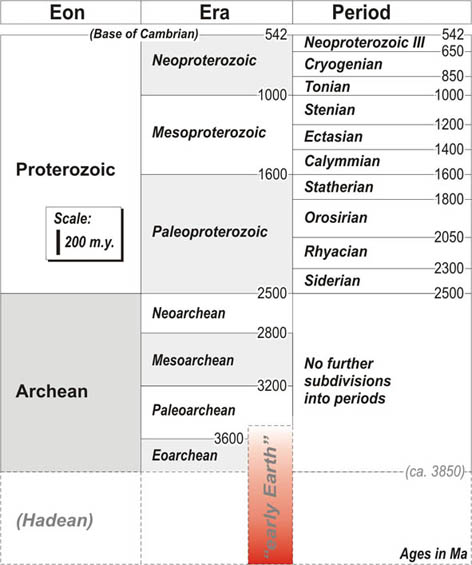
Precambrian time scale, the status quo (from Bleeker, 2004; adapted from Plumb, 1991)
The figure below shows the current status of the Precambrian time scale, as put forward by the previous Subcommission on Precambrian Stratigraphy (Plumb, 1991; see also Lumbers and Card, 1991). Boundaries were defined chronometrically in terms of absolute ages, and were chosen to coincide with perceived gaps in the global stratigraphic record. The Proterozoic Eon and its subdivision were formally ratified, whereas the Archean and its era-rank subdivision remain informal (“recommended”). As it stands, the Archean has no formal beginning. The Eoarchean era has not received wide acceptance, with most authors and organizations implicitely maintaining a three-fold subdivision of the Archean instead.
For completeness, the widely but somewhat inconsistently used, and still informal Hadean eon has been added here to the figure. This useful term, first introduced by Preston Cloud (1972), to highlight that part of Earth’s history for which there is little or no meaningful rock record, urgently requires formal definition. A suitable and pragmatic definition for the Hadean-Archean boundary would be the “first appearance” of preserved supracrustal rocks in the geological record. This definition could form the basis for a base-Archean GSSP, perhaps at Isua (SW Greenland) or in Canada. In the absence of a suitable language to describe the first couple hundred million years, the informal term “early Earth” has become popular among early Earth researchers and planetary scientists. In its broadest sense, this term could be interpreted as Earth’s first gigayear.

Of course, the terminal period of the Neoproterozoic has now been renamed the Ediacaran (see Terminal Proterozoic), with its onset pegged to a GSSP at Enorama Creek, Australia, defined by the onset of the cap carbonates overlying Marinoan glacial deposits (e.g., Knoll et al., 2004a; Knoll et al., 2004b).
For a colour version of the Precambrian time scale, see the official ICS chart.
Relevant References: